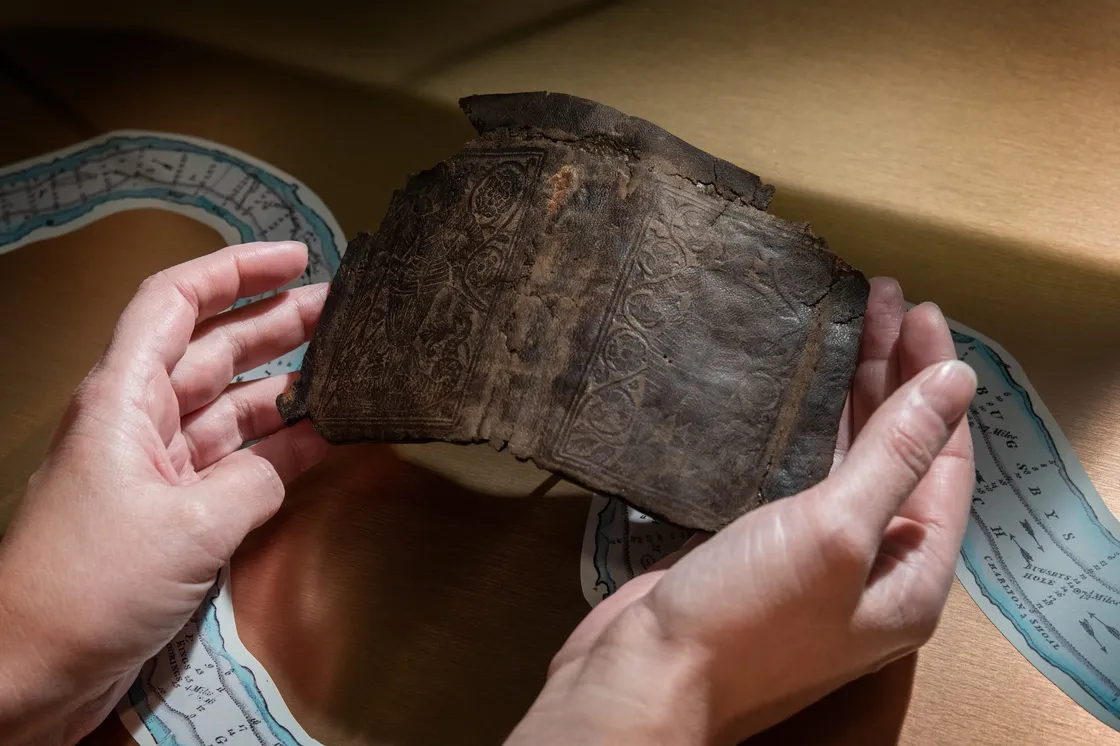17 March 2025 — By Kate Sumnall
From tiny to titanic: Mudlarking treasures on display
The Thames unveils London's forgotten past – from tiny, weighted dice to massive parts of gun carriages. Discover medieval gambling cheats, elegant rapiers and even risqué artefacts at the Secrets of the Thames exhibition.
The Thames foreshore has been the holder of London’s secrets for centuries, preserving objects both minute and massive in its muddy foreshore. The Secrets of the Thames exhibition showcases an extraordinary range of objects – from tiny, weighted dice to large parts of wooden gun carriages – each protected by the river until their discovery.
“These finds have been waiting to tell their stories after centuries of silence beneath the flowing waters of London’s great river”
The magic of mudlarking lies in its unpredictability, with each low tide you never know what might be found sometimes it reveals artefacts untouched for hundreds, even thousands, of years.
All aspects of life can be found preserved in the Thames mud, from the rare and special moments to the fragments of the everyday. These finds have been waiting to tell their stories after centuries of silence beneath the flowing waters of London’s great river.
As you visit the Secrets of the Thames exhibition, try to find all these yourself.
Smallest: A set of 24 weighted dice

Loaded dice found by Antony Allen.
Among the exhibition’s smallest treasures are 24 bone dice, each barely a few millimetres in size, discovered in a small lead pot that had been squeezed shut to keep the dice inside.
Despite their diminutive size, these late 15th-century artefacts reveal London's gambling history with a fascinating twist. X-ray analysis exposed them as "loaded dice". Some were strategically weighted with mercury, others had repeated numbers to ensure they rolled either high or low numbers.
By the mid-16th century, such cheating dice were known as "fulhams", named after the riverside village of Fulham, reportedly a haven for gamblers looking to tip the odds in their favour and win the cash being wagered.
Longest: A rapier sword

In the 1500s, the rapier was used in the sport of fencing.
This rapier stretches an impressive 1.42-metre long. Swords like these were very popular during the 1500s used in the sport of fencing. Sword-fighting schools sprang up in Elizabethan London to meet the demand and there was fierce rivalry between the Italian masters and the English ones.
English fencers saw the rapier as a foreign weapon but to the Italians who favoured the rapier, they called it ‘the Queen of Weapons’. By 1594, when this rapier was made, the fashion had caused the blades to be made longer and longer, adding to their dramatic appearance.

A conservator holding the rapier, which will be on display in the exhibition.
Heaviest: Gun carriage pieces
Two objects count as the heaviest on display – possibly part of the same object – a wooden gun carriage.
Gun carriages like these were used on board warships or military ships to support iron guns, helping them to be manoeuvred and fired.

A conservator placing parts of the gun carriage for display in the exhibition.
The wooden pieces were found on the Thames foreshore where decommissioned ships were towed up the Thames and broken apart to salvage all useable parts. The larger timbers were taken away and reused. Smaller pieces like these from the gun carriages were laid on the foreshore to help stabilise it for the workers. Ship-breaking was a huge and vital part of London's Thames-side economy.
Cutest: Tiny, little decorative beast
While we acknowledge that cuteness lies in the eyes of the beholder, when you see this tiny, winged beast sitting patiently, we’re sure you’ll agree with us. Smaller than a 5-pence coin, this mini dragon or bird was made and worn 500 years ago. It’s so small that the easiest way to hold it is with tweezers.

The 'tiniest' dragon in London.
Intended to decorate a belt, when it was new it would have shone brightly against the leather. It was highly fashionable in medieval London to have your belt decorated with many metal studs and mounts forming patterns. These studs come in many different sizes and shapes including stars, moons, hearts, flowers, letters, beasts and birds like this one. This made belts personalised and with meaning to the wearer as well as being very eye-catching.
Rarest: Leather binding from a book of prayers
A mudlark spotted this leather scrap on the foreshore. Once home, cleaning revealed it was a small book binding decorated with a man in armour with a dog at his feet at the front and on the back, St George and the dragon.

This leather book cover is a rare survival because everyday books like these just don't survive.
Research suggests it was from a prayer book dating to the 1500s. This would have been an affordable book and found in many London homes. These books are sometimes called primers as they were used to teach children to read at home.
This is a rare discovery as surviving examples tend to be from large and expensive books, and it was the fashion to re-cover them to suit more modern tastes. Everyday books, like this one, were not added to libraries or collections and so just don’t survive.
Sneakily NSFW: Phallus in a purse badge

The phallus image in the purse badge could have stood for luck and fertility.
All sorts of treasures are found on the foreshore, some more titillating than others. Over the years, mudlarks have discovered a variety of objects decorated with or in the shape of penises. These were medieval symbols of luck and fertility or sometimes just humorous and satirical. One such item is this 14th–15th century badge shaped like a purse with a phallus tucked inside.
Purses were symbols of good fortune as well as a medieval metaphor for vaginas. These lewd badges are rare finds in London, they were very popular in the Netherlands, but it seems this is one fashion that didn’t catch on.
From a Palaeolithic (400,000–150,000 BCE) flint hand-axe, which is the oldest item on display to a glass eyeball, these mudlarked finds now showcased at the Secrets of the Thames exhibition offer eye-popping insights into London’s fascinating history.
Come, explore the foreshore with us.
Kate Sumnall is Curator, Archaeology at London Museum and Lead Curator of Secrets of the Thames.








